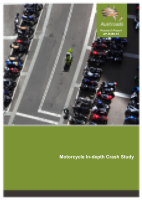Road Safety

- Publication no: AP-R489-15
- ISBN: 978-1-925294-64-4
- Published: 3 November 2015
- PDF (free) Download
Motorcyclists represent an increasing proportion of road crash casualties in NSW and Australia. This study aimed to examine the:
- causal relationships between human, vehicle, road and other environmental factors and motorcyclist involvement in serious injury crashes; and
- influence of the total system (i.e. the rider, the vehicles and the crash site) on the nature and pattern of injuries sustained by seriously injured motorcyclists.
A case-control in-depth crash investigation approach coupled with expert multidisciplinary panel review of cases was used. Cases were motorcyclists who had been seriously or fatally injured in a crash on NSW roads. Controls were riders who had ridden, but not crashed on the same section of road where the case crash occurred.
The results indicate that riders using sports motorcycles and who are unfamiliar with their motorcycle, have a greater likelihood of being involved in serious injury crashes than riders using other motorcycle types and those very familiar with their vehicles. Protective factors identified in the case-control analysis included increasing age of the rider, and increased coverage by protective clothing. An additional protective effect was observed when the trip purpose was reported as commuting or general transport rather than for recreational purposes.
Four major themes arose in relation to crash causation and countermeasures: motorcyclists need to be seen; braking ability needs to be optimised; rider control needs to be maintained; and riders need appropriate experience.
A summary of the research report findings can be downloaded from the supporting documents tab.
- Summary
- 1. Introduction
- 1.1. Study Aims
- 1.2. Report Structure
- 2. Methods
- 2.1. Study Development and Ethics
- 2.2. Data Collection Methods
- 2.2.1. In-depth crash study (cases)
- 2.2.2. Fatality study
- 2.2.3. Case control study
- 2.2.4. Panel review
- 2.3. Analysis Methods
- 2.3.1. Description of crash sample and injury outcomes
- 2.3.2. Case control study
- 2.3.3. Rider reported environmental factors
- 2.3.4. Performance of protective equipment
- 2.3.5. Qualitative analysis of crash and injury causation factors and potential countermeasures
- 3. Results
- 3.1. The Crash Sample
- 3.1.1. Discussion of the crash sample
- 3.2. Case Control Sample Comparisons
- 3.2.1. General characteristics of the case and control samples
- 3.2.2. Characteristics of the case and control samples related to the site specific ride
- 3.2.3. Important points to note regarding the control sample
- 3.3. Case Control Analysis
- 3.3.1. Key findings
- 3.3.2. Description and explanation of case control analysis
- 3.3.3. Important points to note regarding the case control analysis
- 3.4. Rider Reported Environmental Factors
- 3.4.1. Important points to note regarding rider reported environmental factors
- 3.5. Injury Outcomes
- 3.5.1. Important points to note regarding injury outcomes
- 3.6. Performance of Protection Equipment
- 3.6.1. Helmets
- 3.6.2. Protective clothing
- 3.7. Qualitative Analysis of Crash and Injury Causation Factors and Potential Countermeasures
- 3.7.1. Common crash types
- 3.7.2. Crash causation
- 3.7.3. Potential crash avoidance countermeasures
- 3.7.4. Summary of emerging crash causation and countermeasure themes
- 3.7.5. Injury causation
- 3.7.6. Injury countermeasures
- 3.7.7. Summary of emerging injury causation and countermeasure themes
- 3.7.8. Post crash factors
- 3.7.9. Important points to note about the qualitative analysis
- 4. Discussion
- 4.1. Causal relationships
- 4.2. Nature and pattern of injury
- 4.3. Emerging crash prevention themes
- 4.4. Commonalities across themes
- 4.5. Protective equipment
- 4.6. Study limitations
- 4.7. Areas for further study
- References
